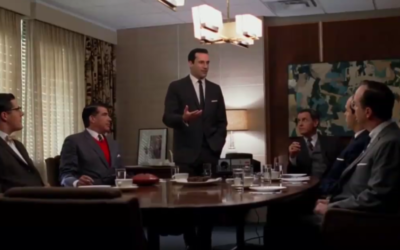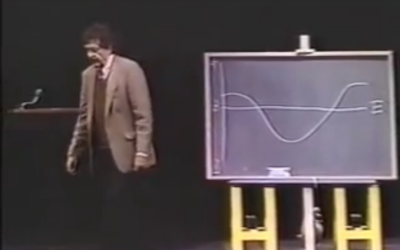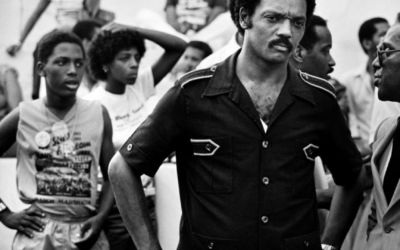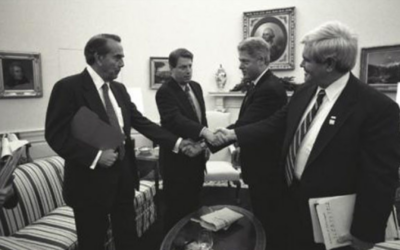What is the Taxi Test? It's a test you apply to the headlines on your slide deck before you send it out. The question you are asking yourself: If someone only reads the headlines on your slides, will they still understand what you are proposing and why? Imagine that...
Presentation Tips
“I need business English” is a dangerous phrase
Why? Because it leads to way too much unfocused effort and time wasting. You're going to waste your time learning how to set meetings and talk to receptionists. I don't mean to malign receptionists, they are great people and the world needs them. But you have an...
The point
In this episode of The White Rabbit podcast... https://open.spotify.com/episode/1cn5bJITDjfxZBOjUeJoSE?si=708e2514c8354bef ...Alper makes an interesting point, that the value of a presentation is not in convincing people to support you, it's in reassuring your...
The right questions
99% of my clients are not native speakers of English. (Fun fact: Did you know that, by far, most speakers of English are not native speakers of English?) And, quite dependably, every single one of those clients asks at some point, "How is my English," or some other...
Stalk the board
This is a great article, it made me so excited and I jumped for joy many times upon reading it! One of my favorite points it makes: Know the board members. Not on average. Every. Single. One. They're all different. I call it "stalk the board"...
RFP presentation tip #2
The second step in our series is to reduce your ahh count. It's much easier to listen to somebody who is not saying "uh" all the time. Let me give you an example. Option 1: I, um, went, um, to the, um, store. Option 2: I went to the store. Read them out loud. Compare...
People are like dogs
If you stare at one long enough, it'll attack. Screen-based teleprompters are great. They allow you to read a script while looking at, or at least appearing to look at, the camera. But don't fall in love with your teleprompter so much that you forget to break eye...
Aspect ratios
"The aspect ratio is off."Said no one in your audience, ever. They probably aren't sitting there thinking, the aspect ratio is off, I don't like this guy.But they might be sitting there thinking, I don't know what it is, but something is off. Maybe it's the color...
RFP presentation tip #3
Make mirror neurons work for you. What are mirror neurons? Basically, it’s that humans tend to do what other humans are doing. You know how if you’re at a party talking to someone, and they are smiling, you’ll smile too, even though you’re not sure why you’re smiling?...
RFP presentation tip #4
Use vivid language. Use words loaded with color. Emotion. Sound. Why? If you use dead or uncolorful words, then when your audience leaves the room, they're going to forget what you said. They're going to forget you. And when you're giving a pitch presentation, being...
Six
There is a magic number for how many filler words are fine. It's six. There are some people on the logical extreme, and they'll say you need to hit zero. And sometimes that would be nice, to hit zero filler words, but in my opinion, don't worry about it too much. Less...
Slides are a crutch
It was the most important presentation of her life. Not just of HER life. Of the lives of every single one of the people who worked for her, too. After all, their jobs at her company were how they put food on the table to feed their children. But they weren't going to...
Don’t feed the monster
Don't feed the monster. Kill it. You don't need prettier slides. You don't need fancy animations or most of the bells and whistles that are built into PowerPoint. You probably don't need to spend hours and hours preparing, if you're already an expert on the subject....
You don’t need more noise
Slides are noise. There are 30 million new slides made every day. No one wakes up in the morning and says, "You know what I need more of in my life? PowerPoint slides." What the world needs more of is the ability to take a one-hour idea and crush it down into 3 or 4...
Tech spend and second marriages
They say that 60% of tech projects fail or underperform. (That number varies, but it's usually north of 50.) Which means tech spend is, like a second marriage, the triumph of hope over experience. Your budget committee presentation is going to be mostly numbers, team...
Go retail
A lot of public speaking coaching is directed at speaking to large groups. You know the images: A speaker, holding a microphone, standing in front of hundreds of people, usually on a stage or something like that. But most big decisions are not made by hundreds of...
What does ChatGPT mean for my presentations?
The short answer: Nothing. If you're a CTO, ChatGPT and AI are helping your coders a lot. They probably save them boatloads of time. They might even be helping clean up their code or even write blocks of code that would be a waste of time for a human. But when you're...
Make your headlines tell your message
Make sure that if someone reads only the headlines of your slides, and nothing else, they will still get your message. For example: Slide 1 headline: Sales are up Slide 2 headline: But average pick lines per order are too Slide 3 headline: So to protect profitability,...
Was Don Draper cool or not?
Elsewhere, I've held up Angus Young, admiring him for his complete lack of detachment. Today, I hold up the opposite, a King of Cool, Mad Men's Don Draper. When you need to be cool and collected in a hot environment, channel your inner Don Draper. But now that I think...
Let your freak flag fly
Look at that guy. He's sweating, he's drooling, he's desperately sucking oxygen through a tube. He's the uncoolest guy that ever existed. And yet… There are tens of thousands of fans calling his name, straining to touch him, like he is a god. You don't need to be...
Alternative CYA phrases
"CYA" (cover your ass) is a great phrase for office life, but sometimes it has connotations of selfishness, like you're saying someone just wants to protect himself, he doesn't really care about the group or the company. Example: "That email was mostly CYA. He just...
Key flagging phrases
Flagging is a way for you to call attention to the main point of your message. There are some key words and phrases that wake people up and tell them to listen carefully. Here are some of them: If you take just one thing away from this, it should be... The most...
Kill your darlings
Before all the other important stuff you might want to know about presenting, the single most important step is a brutal one: “Kill your darlings.” This phrase, often attributed to author William Faulkner, means get rid of the things that mean a lot to you, but that...
It’s not that faces are good or bad
It’s not that faces are good or bad, it’s just that they’re very distracting. One thing that we see often in almost every corporate presentation is there’s an introduction of the company. In that introduction, there will usually be a couple of slides with pictures of...
Yes, X, but the bigger picture is Y
When you want to persuade somebody to choose your argument over another, one of the things that you can do is tie your argument to a bigger picture. For example, we had a client recently who worked for a European bank, and there was an internal debate within the bank...
Fielding challenges from an angry audience member
Sometimes when an emotionally-stated challenge comes from an audience member, as much as 50% of the emotion behind the challenge might be the audience member feeling unheard. They don’t feel like their opinion is understood or being listened to, even if you think it...
“Stories are good” is not actionable advice
"Stories are good, you should use them more often. And it's important to put yourself in your stories." That’s good advice. But these days a lot of people pass out advice like that, and then you ask them to explain themselves, and they tell you stuff like, "It makes...
Don’t bury the lede
When you list things, put the most important thing first. Don't save the best for last: --Most important thing--Second most important thing--Third most important thing--Fourth most important thing Someone in your audience might get called away, your boss in the back...
Unlock the skills you already have
The best presentations use the skills you already have.
The “political changes” question in emerging markets
A question that often comes up in investor conference calls, especially with emerging markets companies, is "How are political or regulatory changes affecting the business environment?” The way your company chooses to answer this question is a stylistic difference....
They don’t know nearly as much as you think they do
Our clients often think that when audience members are high up in the industry or in the company, they already know everything. This is completely wrong. Yes, they are experts in something you are not. But you are an expert in something that they are not. That’s why...
Get to work
Steven Pressfield, the author of The War Of Art, one of my favorite books, once said: “The amateur believes he must first overcome his fear; then he can do his work. The professional knows that fear can never be overcome.” Since you’re a professional, you know what...
The most effective presentations are not presentations at all
The most effective presentations aren't presentations at all. They are conversations, and you probably already have all the skills you need, they just need to be unlocked. Let's say the Big Boss from Headquarters is coming to your regional office for a full day of all...
Wherever you look…
Wherever you look, your audience is probably going to look there too. This is a human trait. You're not going to get around it. There's no amount of presentation training that is going to help you overcome it. If your audience sees you looking at your slides, they...
The CEO on the conference call: Stick to your style
Every CEO has a different style when it comes to handling investor conference calls (for example, an annual earnings report). The styles lie on a spectrum. On the one end, you've got a Jamie Dimon style, which is where the CEO will just say two or three sentences...
“Can you do an unplanned talk for 10 minutes?”
The other day a reader said, "My boss asked me if I could do an unplanned talk for 10 minutes. What do I say, how can I organize my thoughts?" Here's what we suggested... Two things humans almost always find fascinating: 1. Change or movement (think of early humans...
Cultivating audience participation
When the speechwriting is almost done, it’s time to move on to the delivery training. Why do we say “almost done”? Because we need to make sure the speech we’ve written is going to work in real life, and we can’t start to gauge that until we start the training. Does...
How to ask difficult questions?
A reader asks, “How can I ask difficult questions?” You know the kind of questions, the ones where you wonder beforehand if you dare ask them, the ones where you stop first and think things like is that question too forward, or too bold, or is it too early in the...
Swim in my ocean, or splash in my puddle
Before they realize there is huge power in deep preparation, some of our clients at first resist the idea of practicing a lot. They think practicing a lot is going to kill the spontaneity in their speech. What they haven't realized yet is that you will never give the...
Stories happen in the listeners’ heads
There’s a story about Ernest Hemingway. Ernest Hemingway is in a bar with a bunch of other writers. They make a little bet with each other. They say, “How many words do you need to tell a story?” One of the writers, he says he can tell a story in 10 words. Another writer says, […]
The moral of the story
Here we dive deeper into one of the five elements of story structure. This one is perhaps your speech's most important element, but it's usually the most difficult element to communicate clearly... Notes: HGOMM (5 points of story structure) Jesse Jackson speech...
The fastest way to say more
Go slow and speak less. Yes, I know it's counterintuitive. I can barely believe it myself, even though I see it happen almost every day. Here's an example: These days I'm helping a client prepare for a speech at a major committee meeting. It's an important meeting,...
Reader question: example of a marketing story
One of our readers had an excellent question about HGOMM... (HGOMM: the five elements of a marketing story, outlined here: https://recipientlabs.com/hgomm/) His question: Can you send an example of a short marketing story with these 5 components? Yes, of course. An...
Feel sense describe about numbers
One of our readers had a very good question. She watched the Feel Sense Describe video, and asked, "That's nice, but how do I do that when I'm talking about numbers?" Good question. Here's a voice response with two suggestions: By the way, we love to get followup...
More on stories happening in the listeners’ heads
In another blog post, we mentioned that stories happen in the listeners' heads. In presenting, do not underestimate the power of this dynamic. It is a special talent pretty unique to humans. It allows us to organize into groups of millions (nations), or even billions...
Acid test of a good financial speech
How do you know if you’ve written a good financial speech?
Work the crowd
Three tips for working a conversational style into your presentation: 1. In the first 30 seconds of your presentation, ask a couple audience members a simple yes or no question related to your topic (If you are speaking about nutrition: “Murat, did you eat breakfast...
Money is especially emotional
One of the best arguments for how people make decisions on emotion, even when (perhaps especially when) they are making decisions about money, is…
The wrong question
If you’re asking how can I speak better English, you might be asking the wrong question.
You are a midwife
The fastest way to Death By PowerPoint is to think you are anything more than a midwife to the audience’s dreams.
Sometimes…
Sometimes public speaking doesn’t go so well…
The Curse of Knowledge
Actually, attention spans are not shrinking…
At about minute 34:45 in this speech... ...Kevin Spacey makes a very good point: Many people complain about their audience’s shrinking attention span, and yet people still find 12 hours to binge-watch a TV show. So instead of trying to trim things until you can meet...
Look at your people, not your screen
Stop looking at your computer screen!
And that’s how it’s done, folks!
Don Draper shows us how to do a presentation right. Here, notice three things in particular…
Start with a joke. But how?
You don't always need to start with a joke. After all, you are probably not a professional comedian, and no one expects you to be. And starting a speech with an irrelevant joke, no matter how funny it is, like "Two men and a dog walk into a bar..." is almost...
Boy meets girl
American author Kurt Vonnegut diagrams some basic, but very classic, story structures... Believe it or not, the structures he outlines here even work for speeches about corporate debt and global financial crises.
When you use video in a presentation
Videos can make an excellent addition to your presentation. Most of the time they work, but every once in a while they don't, and then you're left there on the stage feeling embarrassed and saying something lame like "Hey, there's supposed to be a video here, but I...
You’re going too fast!
A common issue we see is people speaking too fast, trying to cram too much content into too little time. Fortunately, there’s a very natural way around this. It’s something we’ve been practicing our entire lives, and we do it so naturally we don’t even realize we are...
HGOMM
Check out this short list to learn more about the simplest explanations of the components of a story.
Why Watch Videos of Yourself
There are a lot of reasons to watch videos of yourself practicing. Watching videos of yourself helps you improve your body language, content, your opening and closing. But mainly, watching videos of yourself helps you get out of your head.
Brevity
Brevity is vital. But one thing that often gets lost is that brevity is not enough.
Game tape: Guy Kawasaki, TEDxBerkeley
Guy Kawasaki speaks at TEDxBerkeley, about the 10 points of innovation… Notes: Local references: In this speech, he makes a lot of references to local universities [Stanford, Cal (local nickname for University of California Berkeley), USC (University of Southern California)]. In fact, his very first sentence is about graduating from Stanford (a university near San […]
Do the Flesch-Kincaid
As a speaker, there are a couple numbers you should know. One is your average WPM — how many words do you speak per minute (the average human speaks about 120-130 words per minute). You do that so when you are writing a speech, you know about how many words you have to express your […]
Get them to agree with you first
Sometimes you’re speaking about a hotly-debated topic, something that not everyone in the room agrees with you about. Here’s a tip for those situations: Before you talk about the hot issue, get the audience to agree with you on something else. Two professors, one from Toronto and one from Hong Kong, did a study. They […]
Sidestepping the bomb
Here’s a tip for those times when you’re speaking to a potentially hostile audience, or coming dangerously close to a hot, explosive topic: In your opening sentences, remind the audience you share common ground with them, but also acknowledge the debate. It’s important to do both. Remind the audience of your common ground, so they […]
When you can’t avoid the avalanche
Yes, you compete with your slides for the audience’s attention. When the audience is looking at your slides, they aren’t listening to you. So we preach, over and over, keep your slides simple, keep your slides simple. But in real life, you don’t always control the design, or even the timing, of your slides. Sometimes […]
The Sullivan Nod
Here’s a body language tip: It’s called the Sullivan Nod. When you are talking to an audience, and you are listing three or four or five options, smile and nod when you’re describing the one you want them to choose. Chances are pretty good that they’ll choose it. The “Sullivan” of the Sullivan Nod is […]
Review of a Jesse Jackson speech
In this speech Jesse Jackson, campaigning for US President in 1984, speaks at a church. There are two things I would like to point out in this speech, and they both have to do with point #3 in overcoming the Curse of Knowledge (make it concrete — use simple words and clear imagery): 1. At […]
Reduce your ahh count
For you, as a listener, what’s easier to understand? “I… went… to… the… store…” …or… “Uhhh, I, uhhh… went, uhhh… to, uhhh… the, uhhh… store, uhhh.”? Which one was easier to understand? Probably the first one, right? Both of them took the same amount of time — the first one wasn’t any faster — but […]
Stick to the delta
When you’re organizing your presentation, the Rule of Three is a good place to start. For example: We’re going to do A. We’re going to do B. We’re going to do C. The human brain loves things that are organized into threes. It tends to forget point #4, but it can always remember three things. […]
What should I do with my hands?
When you’re on stage, what do you do with your hands? It’s one of the most common questions we get. Personally, I suspect you already know what to do with your hands, but the best answer is actually kind of zen, so we reserve it for more advanced courses. In the meantime, here are two […]
Chat with a couple audience members
Before your speech, meet some of the members of your audience. Talk to them, get to know them a little. It’ll make you a lot less nervous when you’re speaking, because you’ll be talking to friends, not a bunch of nameless, faceless strangers. How can you do this? At almost every conference, there’s a coffee […]
Video yourself
Have a friend video you while you’re speaking. And yes, watch it! I’ve never met a person who liked to watch himself speaking. Not once. But there’s something magic about it. Every person who ever watches himself on video decides to become a better speaker. It’s like it lights some huge fire inside of people. […]
Practice 25 times
When professional actors prepare for a role, they usually rehearse for hours, or days or weeks, learning how to make a particular facial tick appear at just the right time. When she was preparing for the movie Gravity, Sandra Bullock practiced one of the moves for five months, in order to make it look natural […]
The first three questions
Doing the Bob Dole
To change the world
President John F. Kennedy once said, “The only reason to give a speech is to change the world.” When I first heard that quote, I thought, “Wow, that’s a high bar to set.” People who change the world are people like Winston Churchill, or Nelson Mandela, or Mahatma Gandhi. Not me. The thing is, “changing […]
And then we did this, and it was cool
Recently I was watching a TEDx speech video with a client of mine. The speaker was a designer with a doctorate from MIT, talking about research he’s doing into innovative mechanical solutions. Here’s the video: Neither my client nor I liked the speech. We both came away with a vague feeling that the speaker was […]
Don’t stare at people
People are like dogs. If you stare at one long enough, he’ll attack. When you are giving a presentation, if an audience member gets aggressive and starts challenging you, resist the urge to spend too much time looking at that one person. Address his questions, but look at the other audience members, too, while you’re […]
The famous 70%
The other day, a few of a client’s employees went to a presentation skills training. The trainer told them 70% of presentation is body language, voice tone, etc. My client asked me if I agree. This is what I told her: That 70% figure is bullshit. It’s not bullshit because it’s inaccurate. Maybe that 70% […]
Like saying, “If the sex is bad…”
There are many ways to start a speech. One of them is outlining what you're going to talk about. Watch how Guy Kawasaki does it in the first 90 seconds of his speech... He tells us that he's going to cover 10 points, and that telling your audience you're going to...
Reader question: Is it possible to be a good speaker without perfect language
Put politics aside for a second. Listen to the patterns in this guy's speech, there are a couple things I would like to point out... Below is an anonymized version of the email that points those things out... Hi XXX, I agree completely, you don't need perfect language...
I feel camera-shy
One of our clients asked what he called a “million-dollar question”… He asked, “I feel very shy in front of a camera. How can I improve? Any tips?” Here was my response: “Here's what I do, try this... “Humans naturally relax and light up when they talk to other humans...
Your speech will never be the same twice
You know the saying, “You never cross the same river twice”? That applies to speeches too. The other day I was speaking about my walk across Turkey. Because of a timing mixup, I ended up giving the same speech to two different audiences. To my surprise, the two speeches were completely different. The first speech […]
What do you want your audience to do?
Transcript: Rule number two. Something to remember before you even start outlining your speech. Rule number two or question number two is what do you want your audience to do at the end of your speech. The other day somebody said, “Oh you mean, what’s my goal?” I said, “No, that’s not the question.” What’s […]
Dealing with fear
There are many ways of dealing with fear. Here are two of them: 1. Conquer your fear Try to wrestle your fear to the ground. Try to beat it. Try to control it. 2. Look at something else Your job is not to conquer fear, your job is to do something else. Don’t look at […]
The edge and the center
There are different ways to see the world. One of them is “What can I do on the edge?” Another is “How do I get to the middle?” Before you ever open your mouth, before you even start thinking about a problem, you will, consciously or unconsciously, pick one of these, and your choice will […]
Eye contact is good, but not always
As presentation trainers we tell our clients over and over, “More eye contact, more eye contact.” But sometimes you’ve got other stuff to do, and it’s okay to look away. Not to read your slides or look at your shoes, no. But to visualize something you’re talking about. Like when you’re telling a story. Sometimes […]
No soggy noodles
The other day I was working with a client on her PowerPoint slides. We looked at the first slide, then the second slide, then the third slide. She asked me what I thought. “Should we add this?” “Should we take that out?” The thing is, she had an even more basic problem: her slides were […]
A Google story
Some years ago I heard a story about Google. I forget the details, but the gist of the story sticks with me, and I think of it often… In Google’s early days, before “google” became a verb, when the founders of Google were still just grad students at Stanford, they would periodically get an email. […]
If you can’t explain it simply…
If you can’t explain it simply, you probably don’t understand it well enough. Students come to me often and say, “I want to use more complicated sentences, like a native speaker.” Huh? Expressing yourself well does not mean using complicated sentences. Actually, it usually means the opposite. Expressing yourself well means understanding your idea so […]
Spill your blood onto the floor
There’s a scene I love from the movie Cadillac Records. Beyonce plays Etta James, and she is in the studio recording the famous tune “All I Could Do Is Cry.” The producer tells her it’s not good enough, that she isn’t putting enough emotion into it. Beyonce (Etta James) records it one more time, this […]
You’ll probably never not be nervous
People make a big deal out of being afraid of public speaking. When somebody tells me that they’re afraid of public speaking, I just want to tell them, “You know, you’re never going to get over it.” I’ve been going to Toastmasters meetings for 5 years or more, and I still am nervous as hell […]
Talk to the wall
Transcript: Talk to the wall. What does that mean? Sometimes when you’re doing a speech, before you’re even writing the speech, when you’re just at the very beginning and you’re outlining the idea, sometimes a real rational approach, a really well-thought out approach, works really well. A top-down thing. What do I want to say? […]
Feel, sense, describe – don’t just tell!
Transcript: When you’re practicing and when you’re standing right there on stage, imagine the stuff that you’re talking about. Visualize the things you’re talking about, see them. When you’re talking about flowers, don’t just say, there were some pretty flowers and they were all nice colors and they smelled good. See the colors, see the […]
Put some Tuba in it!
Transcript: This one is called, “Put Some Tuba in It.” When you’re mentoring somebody, I recommend that you tell your mentee to put some of them into their speeches. If their name is Ayşe, or Mehmet, or David, put some Ayşe in it. Put some David in it. Put some Alper in it. Put some […]
Keep your answers short
Q&A (questions and answers) is a great way to break up a speech and make sure you and your audience are thinking in the same direction. However, I often see my clients, when giving an answer, give answers that are too long. The result is that they become less and less sure they are answering […]
Call your audience
Ken Robinson is one of the most popular speakers in the TED community. But it’s not because he’s doing most of the things speech trainers tell us we should do. He doesn’t move around on the stage much. Usually he just stands in one place. His hands hang at his side. Sometimes he even puts […]
Talk to the dog
The other day, I was helping a client with a presentation. He was an engineer for a solar power company, and he was going to introduce his company to some potential investors. Other engineers would have loved his presentation. They would have picked him up, put him on their shoulders, and carried him down the […]














































































